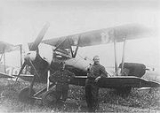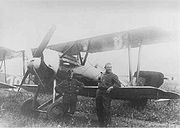
Siemens-Schuckert D.IV
Encyclopedia
The Siemens-Schuckert D.IV was a late-World War I
World War I
World War I , which was predominantly called the World War or the Great War from its occurrence until 1939, and the First World War or World War I thereafter, was a major war centred in Europe that began on 28 July 1914 and lasted until 11 November 1918...
fighter aircraft
Fighter aircraft
A fighter aircraft is a military aircraft designed primarily for air-to-air combat with other aircraft, as opposed to a bomber, which is designed primarily to attack ground targets...
from Siemens-Schuckert
Siemens-Schuckert
Siemens-Schuckert was a German electrical engineering company headquartered in Berlin, Erlangen and Nuremberg that was incorporated into the Siemens AG in 1966....
(SSW). Considered by many to be the best fighter to see action during the war, it reached service too late and was produced in too few numbers to have any effect on the war effort.
Earlier designs
Siemens-Schuckert had entered the fighter-building business with an almost direct copy of the French Nieuport 17Nieuport 17
|-Specifications :-See also:-Bibliography:* Bruce, Jack. "Those Classic Nieuports". Air Enthusiast Quarterly. Number Two, 1976. Bromley, UK:Pilot Press. pp. 137–153....
, the Siemens-Schuckert D.I
Siemens-Schuckert D.I
The Siemens-Schuckert D.I was a German single-seat fighter built by Siemens-Schukert Werke.A number of captured Nieuport 17 fighters were given to German aircraft manufacturers to study, the Siemens-Schukert Werke produced the D.I based on the captured fighter. The D.I was a biplane powered by...
. The plan was to equip it with an engine similar to the Nieuport's 80 CV Le Rhône 9J
Le Rhône 9J
|-See also:-Bibliography:* Lumsden, Alec. British Piston Engines and their Aircraft. Marlborough, Wiltshire: Airlife Publishing, 2003. ISBN 1-85310-294-6....
, which was currently in production in Germany as the Oberursel UR.II. Supplies of the UR.II were extremely limited and none could be spared for SSW's production, so instead SSW decided to start production using their own engine, the Siemens-Halske Sh.I. D.I's were intended to be delivered in late 1915, but, the engine ran into significant delays. By the time they were ready for production in 1916, the design was no longer competitive. After a short run of 95 to be used as trainers, production of the D.I ended.
Siemens-Halske was unhappy with this turn of events, and started work on much larger engine designs to ensure they would not become outdated before entering service. One of these, the Siemens-Halske Sh.III
Siemens-Halske Sh.III
Siemens-Halske's Sh.III was an 11-cylinder, air-cooled rotary engine developed in Germany during World War I, similar to the Sh.I.-Design:It shared with its predecessor the unusual design feature of having its internal workings rotating in a clockwise direction as seen from "nose-on", within the...
, eventually matured into a workable design at 160 PS. Rotary engine
Rotary engine
The rotary engine was an early type of internal-combustion engine, usually designed with an odd number of cylinders per row in a radial configuration, in which the crankshaft remained stationary and the entire cylinder block rotated around it...
s with this sort of power would normally lead to terrible handling problems due to high torque, as it did on the Sopwith Camel
Sopwith Camel
The Sopwith Camel was a British First World War single-seat biplane fighter introduced on the Western Front in 1917. Manufactured by Sopwith Aviation Company, it had a short-coupled fuselage, heavy, powerful rotary engine, and concentrated fire from twin synchronized machine guns. Though difficult...
, but the design team at Siemens-Halske came up with a clever solution to this problem. By running the engine's major interior mechanisms (the crankshaft, connecting rods and pistons) in a clockwise direction as seen from "nose-on", and the crankcase and a very large prop in a counterclockwise direction, the torque was reduced to a large degree. Additionally, a 2:1 ratio set of bevel gears at the rear of the crankcase allowed the engine to run at 1,800 RPM while the propeller spun at 900, allowing for a much larger and more efficient propeller. Without the step-down gearing a rotary would normally run at the same speed as the propeller, forcing the designer to trade off efficiency in either the engine or prop.
The Sh.III led to all of SSW's existing designs being re-engined for testing. In the case of the D.I, this led to a series of three prototype machines in known as the D.II, D.IIa and D.IIb. The primary difference between them and the original D.I was a much rounder and wider front fuselage to hold the larger engine, leading to a rather stubby-looking aircraft which pilots later referred to as the flying beer barrel. Flight tests started in June 1917, and while the plane did not have a very high top speed, it outclimbed anything else in the air. The only serious concern was the extremely long landing gear needed to keep the huge 2-bladed prop clear of the ground.
D.III
Three more prototypes were ordered, two D.IIc's with shorter and longer span wings, and the D.IIe with the original sized wings. After completion in October 1917 the design proved to be worth producing, and in December an order for twenty long-span D.IIc's was placed with a smaller 4-bladed propeller that allowed for shorter landing gear legs. These aircraft, now known as D.III, started delivery in January and were followed by an order for thirty more in February.All fifty were delivered to front-line units in May, where they proved popular. However after only 10 hours of service the engines started showing serious problems, overheating and eventually seizing. Although Siemens blamed the problem on the Voltol-based oil that was used to replace scarce castor oil
Castor oil
Castor oil is a vegetable oil obtained from the castor bean . Castor oil is a colorless to very pale yellow liquid with mild or no odor or taste. Its boiling point is and its density is 961 kg/m3...
used to lubricate the engine, the planes were withdrawn from service and replaced by Fokker D.VII
Fokker D.VII
The Fokker D.VII was a German World War I fighter aircraft designed by Reinhold Platz of the Fokker-Flugzeugwerke. Germany produced around 3,300 D.VII aircraft in the summer and autumn of 1918. In service, the D.VII quickly proved itself to be a formidable aircraft...
's. When they were removed Rudolf Berthold, commander of JG.II, noted that he felt the Siemens fighter be made available again for front-line use as quickly as possible for, after elimination of the present faults, it is likely to be become one of our most useful fighter aircraft.
A version of the Sh.III passed a full 40-hour endurance test in June and the planes were cleared to return to service in July. In the meantime they had been upgraded with the addition of a new rudder, balanced ailerons and a cut-away cowling for better cooling. Some sources also claim that the original engines were replaced with the improved 200 PS Sh.IIIa engines. An additional thirty new aircraft with these features were also built and all eighty of the improved design soon entered service in home defense units where their high climb rates made them excellent interceptor
Interceptor aircraft
An interceptor aircraft is a type of fighter aircraft designed specifically to prevent missions of enemy aircraft, particularly bombers and reconnaissance aircraft. Interceptors generally rely on high speed and powerful armament in order to complete their mission as quickly as possible and set up...
s.
D.IV

Chord (aircraft)
In aeronautics, chord refers to the imaginary straight line joining the trailing edge and the center of curvature of the leading edge of the cross-section of an airfoil...
upper and lower wings, using the Göttingen 180 airfoil, each of 1.00 meter dimension from leading to trailing edge, the performance improved noticeably, both in top speed and in climb rate. An order for this model, now known as the D.IV, was placed in March 1918, and followed with several additional orders as the qualities of the design became obvious. The planes started reaching operational units in August, but of the 280 ordered only 123 were completed by the end of the war, about half of those reaching operational units. In October 1918 it was officially described as superior by far to all single-seaters in use.
Although the short landing gear and limited prop clearance led to tricky landing, the plane was otherwise easy to fly. It had a very short take-off run, and at heights above 4,000 m (13,100 ft) was faster and more manoeuvrable than the Fokker D.VII
Fokker D.VII
The Fokker D.VII was a German World War I fighter aircraft designed by Reinhold Platz of the Fokker-Flugzeugwerke. Germany produced around 3,300 D.VII aircraft in the summer and autumn of 1918. In service, the D.VII quickly proved itself to be a formidable aircraft...
, at that point considered by all to be the best aircraft flying. Its most notable feature was its phenomenal rate of climb and extremely high service ceiling—it could reach 6,000 m (19,700 ft) in less than 14½ minutes. In 36 minutes it could reach 8,100 m (26,600 ft), about 1,200 m (3,900 ft) higher than the Fokker's maximum altitude.
Production of the D.IV continued after the cease-fire, with many being sold to Switzerland
Switzerland
Switzerland name of one of the Swiss cantons. ; ; ; or ), in its full name the Swiss Confederation , is a federal republic consisting of 26 cantons, with Bern as the seat of the federal authorities. The country is situated in Western Europe,Or Central Europe depending on the definition....
where they operated into the late 1920s. With the signing of the Treaty of Versailles
Treaty of Versailles
The Treaty of Versailles was one of the peace treaties at the end of World War I. It ended the state of war between Germany and the Allied Powers. It was signed on 28 June 1919, exactly five years after the assassination of Archduke Franz Ferdinand. The other Central Powers on the German side of...
all aircraft production in Germany was outlawed, and the aircraft portion of SSW disappeared. Siemens-Halske remained, later reorganizing into Bramo.

